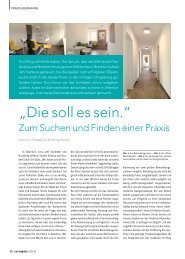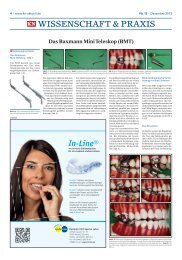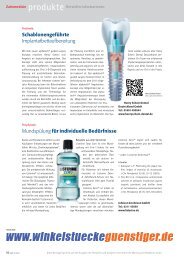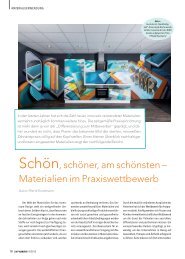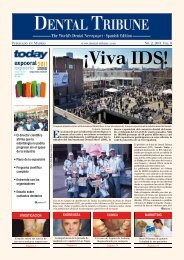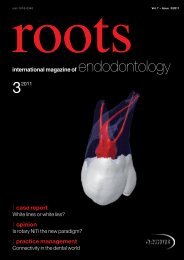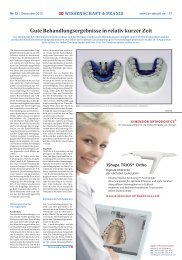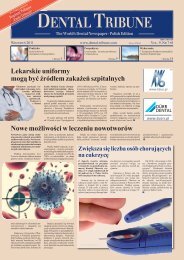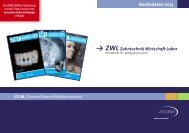Download - Oemus Media AG
Download - Oemus Media AG
Download - Oemus Media AG
You also want an ePaper? Increase the reach of your titles
YUMPU automatically turns print PDFs into web optimized ePapers that Google loves.
DeNtal tribuNe | april-June, 2010 trends & applications 25<br />
Miniscrews—a focal point in practice<br />
Six-part series by Dr Björn Ludwig, Dr Bettina Glasl, Dr Thomas Lietz, & Prof. Jörg A. Lisson—Part IV<br />
Figs. 1a–c: Figs. 1a–d: The uprighting of a second molar with simultaneous reshaping of the dental arch. The problem is clearly visible in the X-ray. The uprighting spring is fixed to a miniscrew (a, b). Status<br />
after five months without reactivation of the arch section (c, d).<br />
Clinical examples (2)<br />
Repositioning individual teeth<br />
The uprighting of molars<br />
The straightening of mesially<br />
tipped (2 nd ) molars in a full dentition<br />
represents a therapeutic<br />
challenge. The treatment is further<br />
complicated if the tooth is<br />
not only tipped but also partly<br />
impacted. The presence of a nonerupted<br />
third molar does not<br />
simplify the process (Fig. 1a).<br />
When planning the required<br />
appliance, it is important to consider<br />
whether it is necessary,<br />
for example, to reshape the<br />
entire dental arch (Figs. 1a–d)<br />
or just upright the tipped tooth.<br />
If miniscrews with bracket<br />
heads are used, it is possible to<br />
employ a special NiTi uprighting<br />
spring (such as the Memory<br />
Titanol spring, FORESTADENT).<br />
A standard multi-bracket appliance<br />
can be used to reshape<br />
the dental arch. At the same time,<br />
a second force element can be<br />
applied with the aid of a miniscrew<br />
and an uprighting spring<br />
(Figs. 1b–d). This avoids the loss<br />
of anchorage that inevitably<br />
occurs when only an uprighting<br />
spring is fixed to the multibracket<br />
appliance (Fig. 2). The<br />
straightening of an individual<br />
tooth may become necessary<br />
for periodontological, prosthetic<br />
or orthodontic reasons. This is a<br />
very simple procedure if a miniscrew<br />
and uprighting spring<br />
are used, and the appliance remains<br />
invisible to the observer.<br />
The tooth need only be fitted<br />
with an appropriate attachment<br />
system that makes it possible to<br />
fix this to the uprighting spring.<br />
Depending on how the spring is<br />
Figs. 3a–c: The alignment of a displaced canine using a miniscrew. After the canines have been exposed, they are attached to a bracket by means of a miniscrew<br />
(a). After removal of the screw, the dental arch can be reshaped using a conventional technique (b, c).<br />
Fig. 2: The uprighting spring fixed to the main arch not only affects the molars, but<br />
also causes displacement of the premolars (loss of anchorage). (Photo: Prof.<br />
Dominguez, São Paulo, Brasil).<br />
nents tend to move towards each<br />
other. In the worst-case scenario,<br />
only the group providing<br />
anchorage is displaced from its<br />
original position. This can occur<br />
if there is ankylosis of the retinated<br />
tooth, something that is<br />
difficult to evaluate during initial<br />
examination. If an attempt is<br />
made to move an ankylosed<br />
canine towards insufficient dental<br />
anchorage, the result will be<br />
Figs. 4a–e: Obtaining additional transverse space by means of ‘hybrid RPE’. The initial diagnosis is an asymmetrical narrow jaw with insufficient space for tooth 13 (a). After fixture of the brackets,<br />
two mini screws (OrthoEasy) were inserted during the same session (b). The hybrid RPE appliance was attached to the miniscrews and molar bands using laboratory abutments (FORESTADENT; c). The<br />
diastema shows the effect of the appliance after ten days’ use (d). Status after transverse expansion and concurrent reshaping of the dental arch (e).<br />
Fig. 5: The hybrid RPE appliance with adjuvant anterior hooks for the attachment<br />
of a Delaire mask.<br />
set, it is even possible to achieve<br />
intrusion/extrusion of the tooth.<br />
This form of treatment is in expensive<br />
for the patient and the<br />
orthodontist will find it highly<br />
effective.<br />
Alignment of retinated<br />
teeth<br />
The alignment of retained or<br />
displaced teeth, particularly in<br />
the case of canines, is one of<br />
the most common forms of surgical<br />
intervention in the field of<br />
orthodontic techniques. Numerous<br />
appliances are available—<br />
rubber bands, springs, orthodontic<br />
chains—that are effective<br />
to a greater or lesser extent.<br />
All these mechanisms have<br />
the same underlying problem:<br />
the neighbouring teeth must be<br />
used—directly or indirectly—to<br />
provide an anchorage, so that<br />
the required traction forces can<br />
be applied. Ideally, the neighbouring<br />
teeth will offer the<br />
greater resistance so that only<br />
the retained tooth moves. Realistically,<br />
however, both compo-<br />
the worst-case scenario. This<br />
can lead to an open bite in the<br />
region of the anterior teeth and<br />
premolars. Miniscrews provide<br />
the definitive form of anchorage<br />
for the alignment of displaced<br />
teeth (Figs. 3a–c). If sufficient<br />
space is available, brackets will<br />
not be needed in the initial phase<br />
of treatment.<br />
Skeletal adjustments<br />
Palatine suture expansion<br />
Rapid palatal expansion (RPE) is<br />
one of the most effective and



